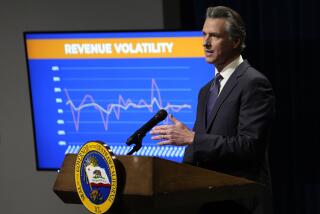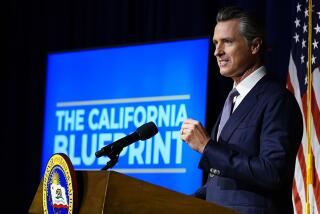Vasconcellos Plan May Point the Way : Proposal should form a framework for budget
- Share via
The Legislature rarely makes the June 15 constitutional deadline for passing a new state budget, and this year was no different. But must this be the start of another protracted budget fiasco like last year? Not if Gov. Pete Wilson and legislative leaders look for fiscally responsible ways past the state’s recession-exacerbated budget problems. That means an extension of the state sales tax and a multiyear budget plan.
Wilson has proposed a Draconian $2.6-billion shift in property tax revenues from counties and cities to the state’s public schools. The governor wants local governments to impose their own taxes to make up the shortfall, arguing that this will return decision-making to the local level. Wilson’s idea has merit, but the timing is bad.
Fiscal problems must be handled in a way that does not undercut the state economy and put new demands on already strained government services and welfare programs. Wilson’s plan might increase the state’s economic problems, setting back a fragile recovery now under way in some sectors of the economy. And because the state’s fiscal problems have been many years in the making, it is not unreasonable to consider a multiyear solution.
Assemblyman John Vasconcellos (D-Santa Clara), who chaired the joint Assembly-Senate committee that wrote the budget plan voted down Tuesday night, was at least on the right course. Vasconcellos’ goal is to mitigate the hits on local governments and set aside funds to pay off a state deficit that has been carried over from 1992.
Vasconcellos’ plan is less disruptive and signals bond rating agencies that California is trying to get its fiscal house in order. He would extend the temporary half-cent sales tax for three years, dedicating the funds for the first two years to repaying the state’s $2.9-billion deficit. In the third year the tax would be used to forgive loans that public schools have been forced to accept from the state as part of their budget. He would also shift only $1.2 billion of property tax revenues from local governments to schools.
Vasconcellos also included emergency triggers in his plan, giving the governor authority to make any cuts needed to keep California’s budget balanced on a quarterly basis. This would keep the state off the slippery slope that created the massive federal deficit.
Vasconcellos’ budget is still austere. Welfare grants would be cut. Fees at state colleges and universities would go up again. And the plan would eliminate the renters tax credit. Some of these details may change, but the basic sales tax extension/multiyear tax approach should remain a framework for a budget--one that, of course, will make no one completely happy, as was the case last year.
If other Democrats, and Wilson and the Republicans, can approach their budgetary work in a similarly pragmatic manner, California can have a fiscally responsible budget before the end of this month.
More to Read
Get the L.A. Times Politics newsletter
Deeply reported insights into legislation, politics and policy from Sacramento, Washington and beyond. In your inbox twice per week.
You may occasionally receive promotional content from the Los Angeles Times.










